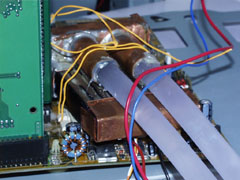Phase II Liquid Cooler
After my positive experience with Phase I I decided to try for something
a little more sophisticated. Phase II was my attemp to maximize the efficiency of a liquid cooled
heatsink.
NOTE: You can click on the images to get (slightly) bigger versions.
 Instead of using 10 quarter inch tubes that didn't fit very well I decided to use 80 3/32 inch
tubes. Not only was the fit great but the surface area was very large. The tubes were coated
in a thin layer of thermal paste from ComputerNerd USA (
www.computernerd.com). The ends of the tubes were held in
place with epoxy.
Instead of using 10 quarter inch tubes that didn't fit very well I decided to use 80 3/32 inch
tubes. Not only was the fit great but the surface area was very large. The tubes were coated
in a thin layer of thermal paste from ComputerNerd USA (
www.computernerd.com). The ends of the tubes were held in
place with epoxy.
 Here is another shot of the heatsink and tubes. You can see a thin layer of epoxy on the top
on the heatsink. This not only served to hold things in place but it also sealed the unit to
make it 100% water tight.
Here is another shot of the heatsink and tubes. You can see a thin layer of epoxy on the top
on the heatsink. This not only served to hold things in place but it also sealed the unit to
make it 100% water tight.
 It took a lot of help from a soldering master to get the end caps in place but here is the
result. Each endcap is basically a copper box. The end with the 5/8 copper tubes in it has a
partition which seperates the in from the out. The flow is designed to flow down one side,
make a U-turn in the endcap and flow up the other side. The area of water flow that the
tubes could handle was roughly double my ability to feed it thus the need for the U-turn.
It took a lot of help from a soldering master to get the end caps in place but here is the
result. Each endcap is basically a copper box. The end with the 5/8 copper tubes in it has a
partition which seperates the in from the out. The flow is designed to flow down one side,
make a U-turn in the endcap and flow up the other side. The area of water flow that the
tubes could handle was roughly double my ability to feed it thus the need for the U-turn.
 I needed to know if the unit was 100% water tight so I let it run for several hours and let
it build up ice. I put another heatsink on the cold plate and a small sheet of copper on
top of that. It didn't take long to get ice to build up. I used a different peltier for Phase
II. It is a 30mm (1.18"), 2.5amp, 21.4 Watt unit.
I needed to know if the unit was 100% water tight so I let it run for several hours and let
it build up ice. I put another heatsink on the cold plate and a small sheet of copper on
top of that. It didn't take long to get ice to build up. I used a different peltier for Phase
II. It is a 30mm (1.18"), 2.5amp, 21.4 Watt unit.
 Once I was sure that the unit was water tight I mounted it on one of my motherboards. Since
I didn't want to risk my main PC I ran it on my 166MMX (overclocked to 75x3 @ 2.8v). The
motherboard is a cheap Matsonic VXpro piece of junk. No great loss if I fried it! The liquid
cooler worked great though. No leaks! My standard heatsink and fan can keep the CPU around
100F, the liquid cooler kept it at 60F with 90F water and 30F with 50F water.
Once I was sure that the unit was water tight I mounted it on one of my motherboards. Since
I didn't want to risk my main PC I ran it on my 166MMX (overclocked to 75x3 @ 2.8v). The
motherboard is a cheap Matsonic VXpro piece of junk. No great loss if I fried it! The liquid
cooler worked great though. No leaks! My standard heatsink and fan can keep the CPU around
100F, the liquid cooler kept it at 60F with 90F water and 30F with 50F water.
Check out my Temperature Graphs!
Go Back
All images and data Copyright 1998 Larkin Lowrey
 Instead of using 10 quarter inch tubes that didn't fit very well I decided to use 80 3/32 inch
tubes. Not only was the fit great but the surface area was very large. The tubes were coated
in a thin layer of thermal paste from ComputerNerd USA (
www.computernerd.com). The ends of the tubes were held in
place with epoxy.
Instead of using 10 quarter inch tubes that didn't fit very well I decided to use 80 3/32 inch
tubes. Not only was the fit great but the surface area was very large. The tubes were coated
in a thin layer of thermal paste from ComputerNerd USA (
www.computernerd.com). The ends of the tubes were held in
place with epoxy.



